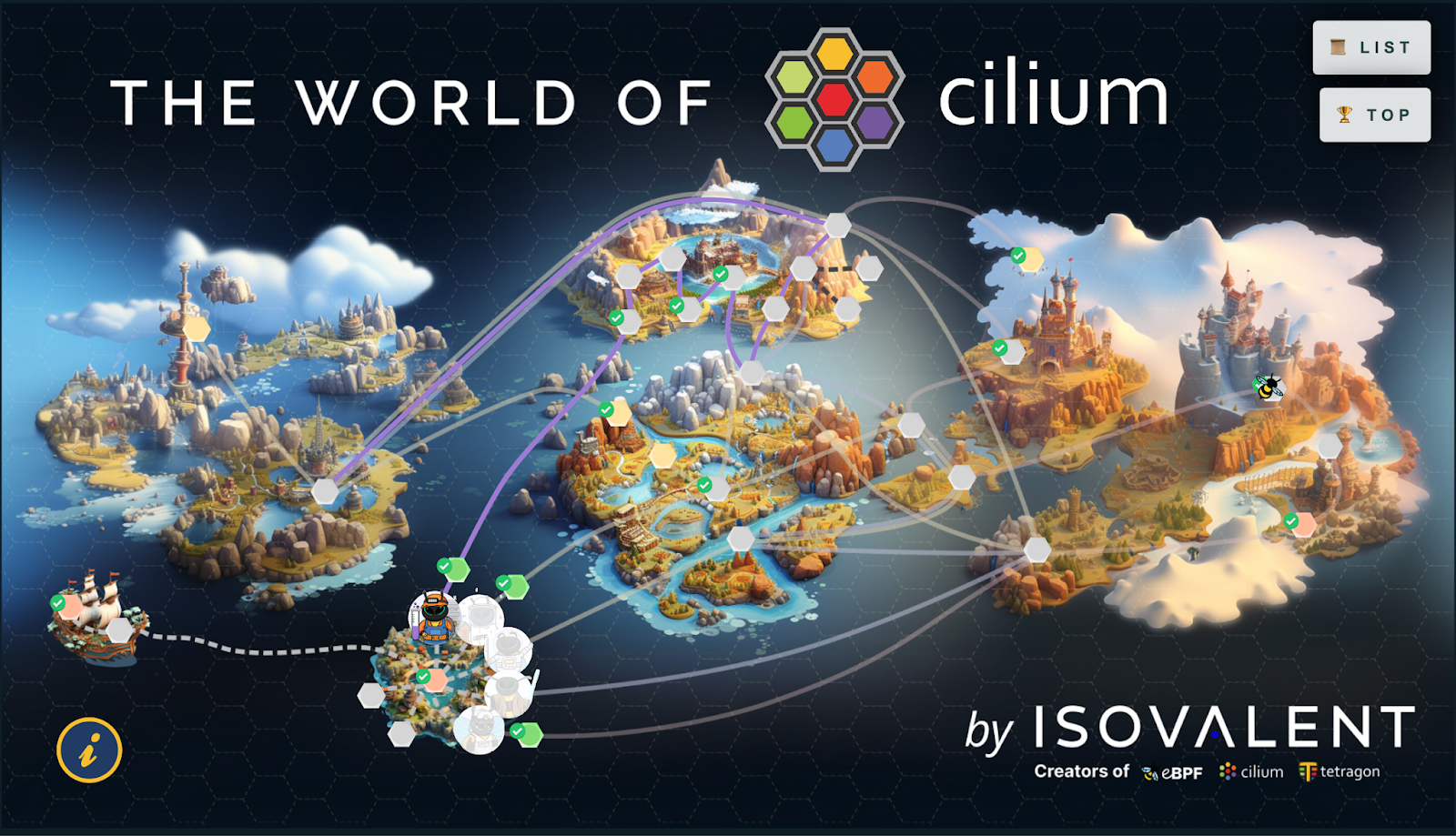[Guest Post] How to Build a Go Proxy to Simplify Access to Embedded Instruqt Labs

Editor’s Note: We’re thrilled to welcome Raphaël Pinson, Senior Technical Marketing Engineer at Isovalent (the creators of Cilium) as a guest author for this Instruqt blog post. Raphaël and his team recently launched instruqt-go, an open source Go client library for interacting with the Instruqt platform. It provides a simple and convenient way to programmatically access Instruqt's APIs, manage content, retrieve user data and track information. In this blog post, Raphaël shares how they use Instruqt to automate and simplify their labs by building a proxy. Many thanks to Raphaël and the Isovalent team for creating a valuable resource for Instruqt lab creators and educating users on Cilium!

How do you teach a very technical topic to prospects and customers? How do you make it a smooth ride?
At Isovalent, we're passionate about making the learning experience as seamless as possible for our users. Isovalent are the creators of Cilium, the de facto cloud networking platform for Kubernetes. While we love networking and security, we appreciate folks might find it a difficult topic. We thought we would make learning Kubernetes networking fun, so we made it a point to gamify the learning experience. Instruqt provides a great platform to build hands-on labs that can be both technically advanced and engaging for users.
We also believe the user experience should be smooth and the processes fully automated. Fortunately, a lot can be done by leveraging the Instruqt graphQL API. To that purpose, we wrote our own instruqt-go library, which we've decided to open source. The library is designed to help developers automate and integrate with the Instruqt platform with ease.

One of the issues in publishing Instruqt labs is to link user information from Instruqt with that of your own database or CRM. In this first post, we’ll guide you through building a proxy using instruqt-go that:
- collects user identifiers (e.g., HubSpot tokens);
- validates user identity;
- redirects users to a lab with unique access tokens generated via the Instruqt API.
We will then publish the function on Google Cloud Functions.
Why a Proxy
There are various reasons to collect user information in labs:
- It is useful to be able to generate badges (and we love badges) upon completion of the lab (more to come on that in a future post).
- It allows users to show their progress through the labs so they know which ones to take (see for example the Cilium Labs Map).
How to Pass User Data
There are several methods to pass user data to Instruqt tracks.
Custom Parameters
Instruqt custom parameters are very useful to pass any kind of information when starting a track. These fields are simply added to the URL as query parameters, prefixed with icp_. These parameters can also be retrieved in Instruqt webhooks as well as through the Instruqt GraphQL API, making them practical to use.
Until recently, Instruqt encouraged track developers to pass user information (such as name, email, or token) using custom parameters.
However, there are a few downsides to using custom parameters:
- They are not standardized, and Instruqt doesn't interpret them. This means user sessions will show as anonymous in Instruqt reports (and the unique user count might be wrong).
- They are not encrypted by default. You can of course encrypt them for your own keys, but Instruqt will show you the encrypted value in play reports.
- I have seen on multiple occasions custom parameters being lost when users restart a lab. I actually started my own cache database to counter this issue.
Invites
Instruqt invites allow users to create a list of tracks and generate an invitation link that can be shared with users for easy access. Invites can be set to collect user data via a form.
This user data is then added to the user's details on Instruqt (user details are attached to user accounts, but are unique per Instruqt team).
This is extremely practical for workshops, but there's again a few limitations:
- Using an invite to access all labs means that invite must contain all published labs.
- Invites have their own landing page, so it wouldn't work with our Cilium Labs map or other kiosk approaches.
Note: Instruqt recently introduced landing pages, which is a form of invites with a way to tune the landing page, with the same advantages and limitations.
Third Party Forms
Recently, Instruqt added another way to pass user information, which combines the benefits of both previous methods.
The encrypted PII method allows you to pass a pii_tpg query parameter to an embed URL. This means:
- The data is encrypted, using a public key provided by Instruqt, so URLs don't contain readable user information.
- Instruqt understands the pii_tpg data and has the private key to decrypt it. The information is used to fill in the user's details, just as if they had accepted an invite.
- This is not linked to invites, so it can be used with any track.
We're going to use this new method in this example, as it is the most versatile today to pass information to Instruqt in a safe and reliable manner.
A Note on Embed Tokens
When you visit a track page on Instruqt, there is an option to embed the track. This gives you a URL which contains a token unique to the track.
While it is perfectly valid to use that URL, it also means that whoever has access to this token can start the track whenever they want.
Instruqt has recently added an API call to generate one-time tokens for tracks, such that URLs using such tokens can only be used once.
The proxy we're coding will use one-time tokens, since we have access to the API and can easily generate them.
Creating the Proxy
Initial Steps
First, create a directory for your function:
mkdir instruqt-proxyMove to this directory and initialize the Go environment:
# Replace example.com with the prefix of your choice
go mod init example.com/labs
Google Cloud Function Harnessing
For local testing, create a cmd directory:
mkdir cmdCreate a main.go file in that directory, with the following content:
package main
import (
"log"
"os"
// Blank-import the function package so the init() runs
// Adapt if you replaced example.com earlier
_ "example.com/labs"
"github.com/GoogleCloudPlatform/functions-framework-go/funcframework"
)
func main() {
// Use PORT environment variable, or default to 8080.
port := "8080"
if envPort := os.Getenv("PORT"); envPort != "" {
port = envPort
}
if err := funcframework.Start(port); err != nil {
log.Fatalf("funcframework.Start: %v\n", err)
}
}
Creating the Function
Back to the instruqt-proxy directory, create a proxy.go file and start by adding the init() function to it, along with the Go packages we will be using:
package labs
import (
"fmt"
"net/http"
"net/url"
"os"
"github.com/GoogleCloudPlatform/functions-framework-go/functions"
"github.com/isovalent/instruqt-go/instruqt"
)
func init() {
functions.HTTP("InstruqtProxy", instruqtProxy)
}This will allow Google Cloud Functions to call the instruqtProxy function when it is initialized.
Let's write that function:
const (
// Replace team name with yours
instruqtTeam = "isovalent"
)
func instruqtProxy(w http.ResponseWriter, r *http.Request) {
instruqtToken := os.Getenv("INSTRUQT_TOKEN")
if instruqtToken == "" {
w.WriteHeader(http.StatusInternalServerError)
return
}
instruqtClient := instruqt.NewClient(instruqtToken, instruqtTeam)
// Get user from passed token
utk := r.URL.Query().Get("utk")
if utk == "" {
w.WriteHeader(http.StatusUnauthorized)
return
}
user, err := getUser(utk)
if err != nil {
w.WriteHeader(http.StatusUnauthorized)
return
}
labSlug := r.URL.Query().Get("slug")
url, err := getLabURL(instruqtClient, user, labSlug)
if err != nil {
w.WriteHeader(http.StatusNotFound)
return
}
http.Redirect(w, r, url, http.StatusFound)
}In this function, we:
1. Get the Instruqt token from the INSTRUQT_TOKEN environment variable
2. Initialize the Instruqt API client for the token and team
3. Retrieve a utk parameter from the URL parameters in order to authenticate the user
4. Get user information based on that UTK
5. Get the lab slug from the URL parameters
6. Retrieve the lab URL for the redirection
7. Redirect the user using an http.Redirect function
Implement getLabURL()
The getLabURL function will generate the redirect URL for the lab based on user information, the requested lab slug, and dynamic information from the Instruqt API.
Let's write it:
const (
// Replace with your sign-up page format
labSignupPage = "https://isovalent.com/labs/%s"
// Adapt to your values
finishBtnText = "Try your next Lab!"
finishBtnURL = "https://labs-map.isovalent.com/map?lab=%s&showInfo=true"
)
func getLabURL(instruqtClient *instruqt.Client, u user, slug string) (string, error) {
track, err := instruqtClient.GetTrackBySlug(slug)
if err != nil {
return "", err
}
// Unknown user
if u.Email == "" {
url := fmt.Sprintf(labSignupPage, slug)
return url, nil
}
// Get one-time token
token, err := instruqtClient.GenerateOneTimePlayToken(track.Id)
if err != nil {
return "", err
}
labURL, err := url.Parse(fmt.Sprintf("https://play.instruqt.com/embed/%s/tracks/%s", instruqtTeam, track.Slug))
if err != nil {
return "", err
}
// Prepare the fields to encrypt
encryptedPII, err := instruqtClient.EncryptUserPII(u.FirstName, u.LastName, u.Email)
if err != nil {
return "", err
}
// Add params
params := map[string]string{
"token": token,
"pii_tpg": encryptedPII,
"show_challenges": "true",
"finish_btn_target": "_blank",
"finish_btn_text": finishBtnText,
"finish_btn_url": fmt.Sprintf(finishBtnURL, track.Slug),
}
q := labURL.Query()
for key, value := range params {
q.Set(key, value)
}
// Encode the parameters
labURL.RawQuery = q.Encode()
return labURL.String(), nil
}First, note that we have defined some new constants that you can tune:
• labSignupPage is the URL on your website where unauthenticated users will be redirected. It contains a variable for the lab slug.
• finishBtnText is the text shown on the finish button of the lab.
• finishBtnURL is the action of the button at the end of the lab. It also contains a variable for the lab slug.
Now let's explain the getLabURL() function steps:
1, Retrieve track information from the Instruqt API, error if it cannot be found.
2. If the user is unknown, redirect to sign-up page.
3. Generate a one-time token for the embedded track access.
4. Generate the redirect URL.
5. Encrypt user information using the PII key from the Instruqt API.
6. Add all parameters (one-time token, encrypted user information, finish button options) to the redirect URL.
7. Encode the URL.
8. Return the resulting URL.
The getUser() Function
The last piece missing in this proxy is the getUser() function. I can't help you much here, since this part is where you plug your own logic. You might be using a CRM like Hubspot to retrieve contact information from the UTK, or another database, it's up to you!
The code I'll show you here simply returns a sample user:
/*
* This is where you add the logic to get user information from your CRM/database.
*/
type user struct {
FirstName string
LastName string
Email string
}
func getUser(utk string) (u user, err error) {
// Implement the logic to get your user information from UTK
u = user{
FirstName: "John",
LastName: "Doe",
Email: "john@doe.com",
}
return u, err
}
Testing the code
Now that we have our whole proxy.go function, let's test it!
First, update your go.mod and go.sum files with:
go get ./...
go mod tidyIn your Instruqt dashboard, go to "API keys" and get the value of your API key. Export it as a variable in your shell:
export INSTRUQT_TOKEN=<your_instruqt_token>Next, launch the function on your local machine:
FUNCTION_TARGET=InstruqtProxy go run ./cmd/main.goFinally, in another terminal, make test requests to localhost:8080 where your function will be running (you can pass a PORT environment variable above to change the port if necessary):
curl -i "localhost:8080/?slug=cilium-getting-started&utk=someUtkValue"Adapt to use a track slug that exists in your Instruqt organization. If the track exists, you should get a 302 response with the redirect URL containing a one-time token for access, as well as John Doe's information encrypted with the PII key, and a one-time token (starting with ott_)!
Alternative testing: using Docker
If you'd like to use Docker to test your function locally, you can create a Dockerfile in your current directory:
FROM golang:1.23
WORKDIR /app
COPY . .
RUN go build -o myapp ./cmd/main.go
ENV DEV=true
ENV PORT=8080
EXPOSE $PORT
CMD ["./myapp"]Add a docker-compose.yaml file:
version: '3'
services:
proxy:
build: ./
ports:
- "8080:8080"
environment:
INSTRUQT_TOKEN: ${INSTRUQT_TOKEN}
FUNCTION_TARGET: InstruqtProxyFinally, build and launch your container:
docker-compose up --buildAnd you can send requests to localhost:8080 just the same as before!
Hosting the Proxy on Google Cloud Functions
In order to deploy to Google Cloud, first make sure you are logged in to your Google Cloud project:
gcloud auth application-default login
Create a Secret for the API Token
Next, let's create a new secret for the Instruqt token:
echo -n "$INSTRUQT_TOKEN" | gcloud secrets create instruqt-token --data-file=-In order to adjust the permissions on this secret, you will need to get your project ID:
PROJECT_NUMBER=$(gcloud projects describe $(gcloud config get-value project) --format="value(projectNumber)")Then, add the "Secret Manager Secret Accessor" role for the default Compute Engine service account for the project:
gcloud secrets add-iam-policy-binding instruqt-token \
--member="serviceAccount:${PROJECT_NUMBER}-compute@developer.gserviceaccount.com" \
--role="roles/secretmanager.secretAccessor"Your secret is now ready to be used by the function!
Deploy the Function
You can then deploy the function (adapt the region if needed):
gcloud functions deploy "instruqt-proxy" \
--gen2 --runtime=go122 --region=europe-west1 --source=. \
--entry-point="InstruqtProxy" --trigger-http --allow-unauthenticated \
--set-secrets="INSTRUQT_TOKEN=instruqt-token:latest"This will upload and build your project, and return the URL to access the function.
This URL will look something like https://europe-west1-<project>.cloudfunctions.net/instruqt-proxy. You can then test the function using that URL instead of localhost:8080!
Further Considerations
This is a simplified approach to the lab proxy we use at Isovalent. There are things you might want to consider with this implementation:
- If you have actual user (instead of marketing contact), switch to a proper authentication system (e.g. JWT) instead of UTK.
- The current implementation will give access to any lab in your collection if you know its slug. You might want to filter them out (using for example track tags).
- This implementation manages errors but is very basic in logging. We would recommend using Google Cloud logging to easily audit function runs.
- You might want to pass extra information as custom parameters. For example, we like to pass some form of even or campaign ID. These can then be retrieved via the API as part or the Track structure.
- If you're using a custom form and redirecting to the proxy, you might want to be sure your CRM/database has already gotten the user information. You can for example implement a retry logic in the proxy function.
- Invite embed URLs contain the invite ID. If you want to support invites, the proxy could take an optional invite parameter and add it to the URL.
Using the Proxy
This proxy can typically be used to give access to authenticated users in a safe way, while preserving user information in Instruqt reports and making sure embed URLs are not reusable.
Here is an example of usage of this proxy:
- Set up lab sign-up pages with the form system of your choice (e.g. using Hubspot forms).
- Retrieve a user identifier from the page context (e.g. a Hubspot cookie token).
- Redirect users to the proxy, passing the user identifier and lab slug as parameters.
This can allow you to build a series of public sign-up pages for your labs, similar to what we have built on the Isovalent website. It can also be used to build a Kiosk interface, or even a more creative landing page such as the Cilium Labs map, where clicks on the map redirect to the lab proxy.
By making a complex networking technology like Cilium fun with our labs, we have made it the experience for users less intimidating and more approachable. Using our proxy can help you provide a similar user experience to your prospects. Please get in touch if you have any questions.
Explore the instruqt-go library
Head over to Isovalent’s GitHub to access the instruqt-go library, which provides a simple and convenient way to programmatically access Instruqt's APIs, manage content, retrieve user data and track information.
Again, thank you to Raphaël and the Isovalent team for making these resources publicly available!





.png)

